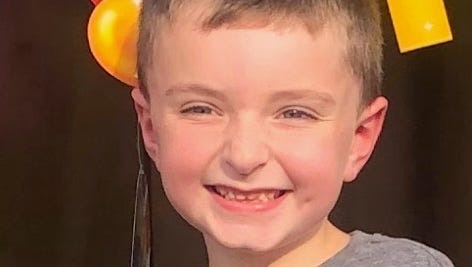
The story of a young boy named Dakota Levi Stevens has captured national attention — not for the joy or milestones a 10-year-old child should be known for, but because of a tragedy that has left a lasting scar on the foster care system in the United States. Dakota’s life was tragically cut short while he was living in what should have been a safe and nurturing environment — a foster home. The details of his final moments are heartbreaking and have sparked an outcry for greater accountability, compassion, and protection for vulnerable children.
This devastating event took place in Berrien County, Michigan, and has raised pressing questions about the adequacy of foster care oversight, the screening of foster parents, and the emotional needs of children who are already facing immense trauma.
A Life Cut Short in a Place Meant for Safety

Dakota Levi Stevens was placed in foster care in early 2024. Like many children entering the foster system, Dakota was seeking a second chance — a new beginning in a home where he could find stability, healing, and love. Sadly, he found none of these.
Just one month after being placed with a foster caregiver, 48-year-old Jennifer Lee Wilson, Dakota’s life came to a tragic end under deeply troubling circumstances. Wilson, who was later charged and convicted of reckless homicide, was meant to be his temporary guardian — someone responsible for his well-being. However, her actions on April 25, 2024, led to an irreversible loss that has shaken communities across Michigan and beyond.
According to court documents and news reports, Dakota had briefly run away earlier that day. He was later found at a neighbor’s house and brought back to his foster home. Once there, he began acting out — behavior not uncommon for children coping with emotional distress or trauma. Reports indicate he threw himself to the ground and appeared to be overwhelmed.
Rather than offering comfort or seeking help from professionals, Wilson made a fatal decision. She sat on him — reportedly using her full body weight of over 340 pounds to restrain the 90-pound boy for nearly five minutes. At the time, she was on the phone with a child welfare caseworker, but she did not stop. According to her own statements, she believed Dakota was pretending. His cries for help were allegedly dismissed, and she did not immediately recognize the severity of his condition.
Eventually, when she turned him over, she noticed he was unresponsive. A child in the household called 911 immediately. Emergency responders arrived, and Dakota was airlifted to a hospital, where he was placed on life support. Despite all efforts, he passed away two days later.
The Medical Findings and Legal Outcome

An autopsy conducted after Dakota’s passing revealed devastating internal injuries. These included severe organ damage, trauma to soft tissues, and hemorrhaging in the liver and lungs. The official cause of death was mechanical asphyxia, meaning he was unable to breathe due to the weight pressing down on him — a form of suffocation caused not by obstruction of airways but by external pressure on the body.
Following a thorough investigation, Jennifer Lee Wilson was arrested and charged. In October 2024, she entered a guilty plea for reckless homicide. By January 2025, she was sentenced to six years in prison, with one year suspended to probation.
While the legal process provided some measure of justice, it also left many questioning how this could have been prevented. How could a child placed under state care be put in a situation so dangerous? How could warning signs be missed?
Signs of Trouble Before the Tragedy
Perhaps one of the most heartbreaking aspects of this story is the insight into Dakota’s own fears. Just 30 minutes before paramedics arrived at the scene, Dakota had once again sought refuge at a neighbor’s home. According to court records, he pleaded with the neighbor to adopt him and told her that he had been harmed by those caring for him. These desperate cries for help suggest a young boy aware of the danger he was in — and powerless to escape it.
This information has further intensified public scrutiny of the child welfare system, particularly the processes used to evaluate and monitor foster parents. At the time of Dakota’s placement, Wilson was caring for other foster children as well. All were removed from her care following this tragedy.
Who Was Dakota Levi Stevens?

Beyond the headlines and legal proceedings, Dakota was a child with a vibrant personality and a love for life. In his obituary, his family described him as someone who “loved the outdoors” and was known for “marching to the beat of his own drum.” These words paint the picture of a free-spirited child who deserved more time — and more love.
His memory now serves as a call to action — to reform systems that failed to protect him and to advocate for those who still need a voice.
A Broken System in Need of Urgent Reform
The foster care system in the United States plays a crucial role in protecting children who cannot safely remain in their homes due to neglect, abuse, or other difficult circumstances. However, this case has laid bare some of the vulnerabilities and flaws in that system.
There are several pressing issues that advocates and experts have raised in the aftermath of Dakota’s death:
-
Stricter Screening of Foster Parents: Comprehensive background checks, psychological evaluations, and ongoing assessments must be non-negotiable. Individuals with a history of aggression, neglect, or emotional instability should not be entrusted with the care of children.
-
More Frequent Home Visits: Child protective services must be equipped with the resources and staffing necessary to conduct regular, unannounced home checks to monitor the emotional and physical well-being of foster children.
-
Mental Health Support for Foster Children: Children in foster care often come from backgrounds of trauma. Providing them with regular therapy, emotional support, and a safe environment should be prioritized.
-
Training for Foster Caregivers: Caregivers must be trained in trauma-informed care, conflict resolution, and behavioral management. Children in the system are not “difficult” — they are hurting.
-
Empowerment of Neighbors and Community Members: The neighbor who tried to help Dakota played a crucial role in bringing awareness to his suffering. Communities should be encouraged and supported in reporting suspected abuse or neglect.
A Legacy of Advocacy
While nothing can undo the suffering Dakota endured, his story is now a powerful reminder of why reform is not just important — it’s urgent. Every child deserves to feel safe, valued, and protected. The foster care system must be a place of healing, not harm.
As a society, we must commit to doing better. For Dakota. For every child currently in foster care. And for the generations to come.
May Dakota Levi Stevens be remembered not for the way he died, but for the light he brought to the world during his short time in it. May his legacy drive real change in a system long overdue for reform.


